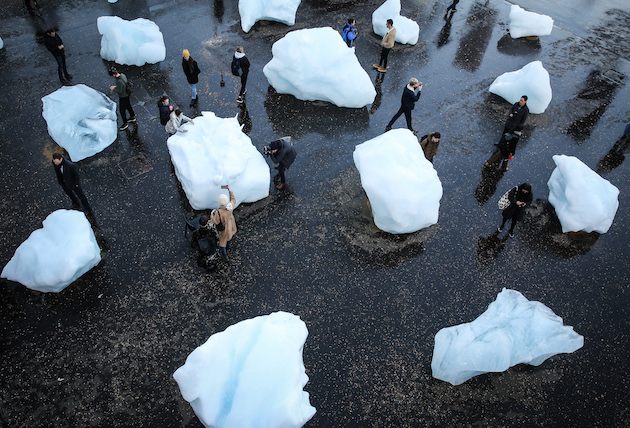 Olafur Eliasson’s Ice Watch on London’s Bankside, by Tate Modern
Olafur Eliasson’s Ice Watch on London’s Bankside, by Tate Modern
London becomes the third city to be visited by Eliasson’s melting marvels
Ice Watch, an artwork of slowly melting blocks of ice by Icelandic-Danish artist-architect Olafur Eliasson, will go on display in London in December.
Outside Tate Modern, on Bankside, 24 blocks will be arranged in a circular formation, while six blocks will be displayed in the City of London outside the Norman Foster-designed Bloomberg HQ, winner of this year’s Stirling Prize.
As the ice gradually thaws, members of the public will be given an opportunity to encounter the tangible effects of climate change by watching and feeling the ice melt, says Eliason.
‘It is clear that we have only a short period of time to limit the extreme effects of climate change,’ said Eliasson. ‘By enabling people to experience and actually touch the blocks of ice in this project, I hope we will connect people to their surroundings in a deeper way and inspire radical change.
The installation is timed to coincide with a meeting of world leaders at the COP24 climate change conference in Katowice, Poland, following a landmark report published on 8 October 2018, which warned that we have just 12 years to limit the worst effects of climate change.
The blocks of ice were sourced from the waters of the Nuup Kangerlua fjord in Greenland, said the curators in a statement, where they were melting into the ocean after having been lost from the ice sheet.
The work goes on show to the public on Tuesday 11 December and is expected to be on view in London until 21 December 2018 – but could melt sooner, if London’s unseasonably warm winter continues, or last longer if the temperature drops.
The Tate Modern – where Eliasson was launched to fame in 2003 with The Weather Project, a glowing artificial sun visible through fog in the Turbine Hall – will launch a major exhibition of Eliasson’s work in July 2019.
London is the third city – after Copenhagen and Paris – to be visited by the Ice Watch. Each instalment is timed to coincide with a global climate change conference.
Eliasson issues a rallying cry for visitors to take action against climate change.
‘We must recognise that together we have the power to take individual actions and to push for systemic change’, says Eliasson. ‘Let’s transform climate knowledge into climate action.’















